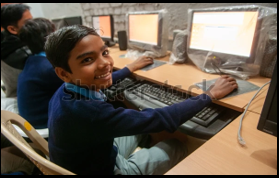

4th July 2022
"Technology will not replace great teachers, but technology in the hands of great teachers can be transformational" - George Couros
The 21st Century has been like no other, characterized by groundbreaking innovations and significant scientific progress and increasing presence in a digital world. Technology has gained a significant position in our lives seeping into most sectors. Digitization has made our lives simpler, efficient and purposeful. That means no pondering over repetitive tasks when digitally fed algorithms can execute the same with greater dexterity, with minimal human intervention. The same notion of the Industrial Age can be applied now when most of our world is shifting online. The long queues at billing the groceries, paying utility bills to even navigating your friend's house have been substituted on smartphones by E-Wallet, E-Commerce and Maps, all at the convenience of a tap.

IMMOBILISED EDUCATION SYSTEM
With respect to the needs of the time, our education system was designed to produce factory workers, not independent critical problem solvers. Rote learning owes much of its purpose here. The problem is its lack of touch with the demands of the present job market, when automation has taken over market and new jobs have sprung into existence.
Through imposing plain paragraphs of theoretical knowledge upon students and testing them solely based on their retention and reproduction of the same, the gap between their learnt skills and employability is widening rapidly. At the same time, the syllabus in the textbooks is not being updated regularly, therefore minimizing the relevance of learnt knowledge. Even though the facts remain the same, it is their timely relevance which matters. It is imperative that creativity will not flourish, if not appealed to the curiosity of the students, therefore the underutilization of our youth's potential.
According to a representative survey conducted in government primary schools, an average of 25% of the teachers are absent on a typical day. The reason for absence also includes official duty, other than truancy. This affects the productivity of the students in the school hours. And to make the matters worse, a UNESCO Report hinted an average pupil teacher ratio of 33:1. These figures are worse in rural government schools, from the secondary level onwards. About 19% of teaching positions lie vacant in India, 69% of which emanates from rural areas. Many of those government schools are run by a single teacher.
However, these figures are on an improving trend. But the question remains - How can India utilize its young manpower to its potential, with increasing digital relevance in background? The answer is School Digitization.

DIGITISATION + EDUCATION = GREAT PROPOSITION
School Digitization is an ongoing process of incorporating elements of the education system into the digital space, through its application in improving knowledge dissemination. This would prepare our students towards engaging in a technologically advancing world, especially with growing relevance in digitization. Its focus is multidisciplinary and tech savvy. It includes the use of digital platforms to collaborate, disseminate and utilize educational tools. They include the utilization of smartboards, computers, tablets, classroom dashboards, etc. The National Education Policy, 2020 has also set digitization in education as one of its primary objectives. With CISCO projecting boom in India's Internet Penetration to about 60%, the stage is being set.
School digitization presents an array for advantages for all the participants of the educational establishment. Cloud Computing would save up rooms of stacked up documentation. With digitization of administrative records to heaps of assignment sheets, maintaining and retaining data would be secure and efficient. Digitalization of the syllabus material would also enable convenient content access for the students. They can revisit the contents and learn at their suited pace. Teachers would also be able to track learning progress of their students, which would enable them to tailor teaching to student's individual needs. Creative appeals of education through the meticulous use of graphics would make the concepts more understandable and applicable for the students. Students will also be prepared for their future careers, in a background where automation would create more opportunities.
HOW WOULD RIGHT TO LIVE CONTRIBUTE TOWARDS SCHOOL DIGITISATION?
Right To Live recognizes the vast potential and importance of digitization in the educational sector and demonstrates its commitment towards the cause through engagement with corporate partners, in projects providing for the following:
SETTING-UP COMPUTER LABS:
It is unfortunate that computer science students in government colleges learn the subject -˜without computers", even in the Silicon Valley of India. Right To Live is engaged in a campaign for setting up computer laboratories with the required resources, including computers, tabs, UPSs, and well-equipped infrastructure to government schools and colleges
SMART-TV
To aid better grasp of academic subjects, we would place 43†LED TVs in computer labs to visually display and explain the material.
TABLETS
In collaboration with BYJUS, the "Education For All" program is ensuring the provision of Android Tablet pre-loaded with e-learning content, in English and the local language, to the students.
There have been improvement strides. It is our duty to ensure that the future global citizens are adequately prepared for a future, continuing our pursued advancements and progress to create an inclusive and a better world. Right to Live requests for your participation in this cause.